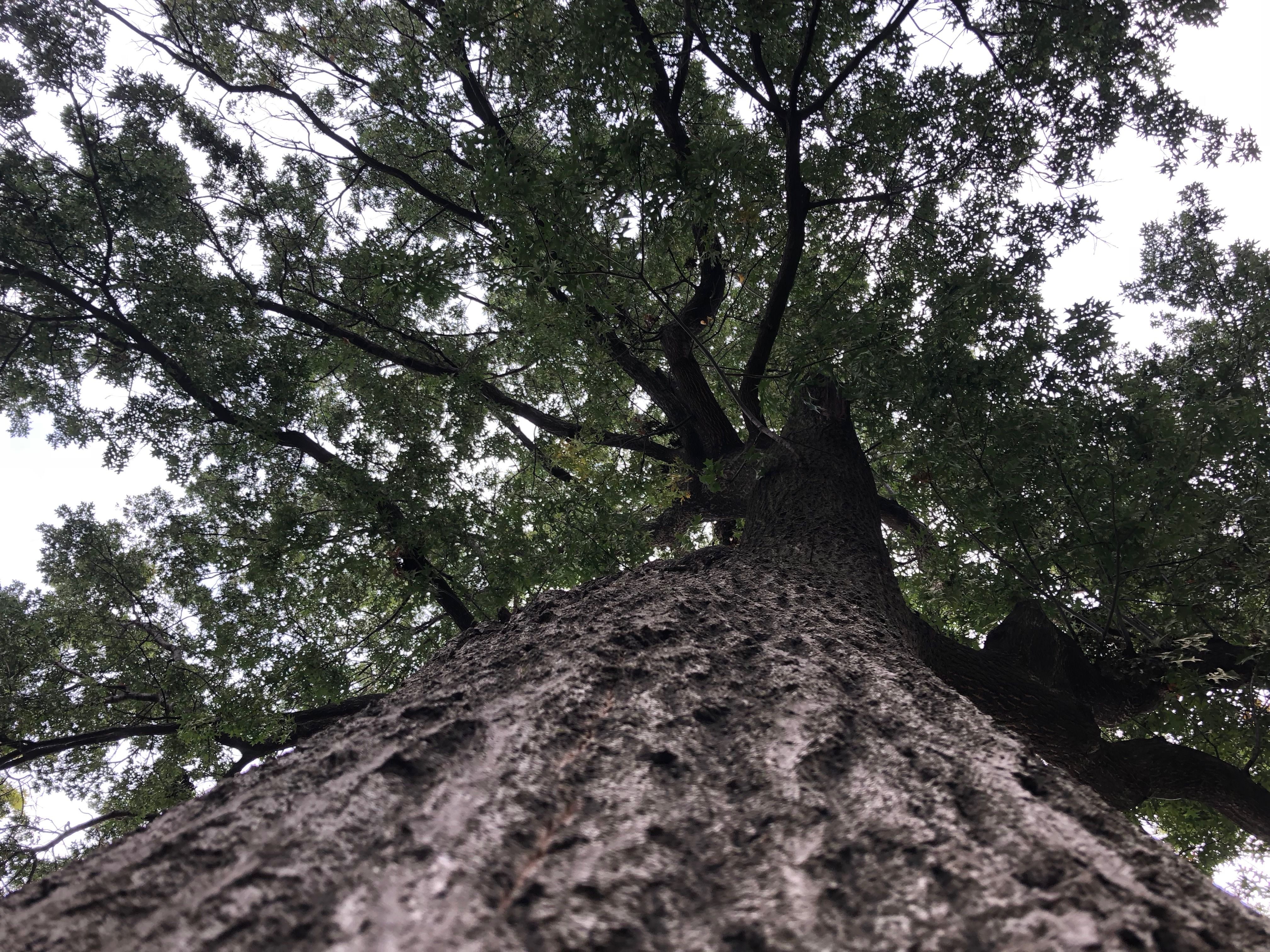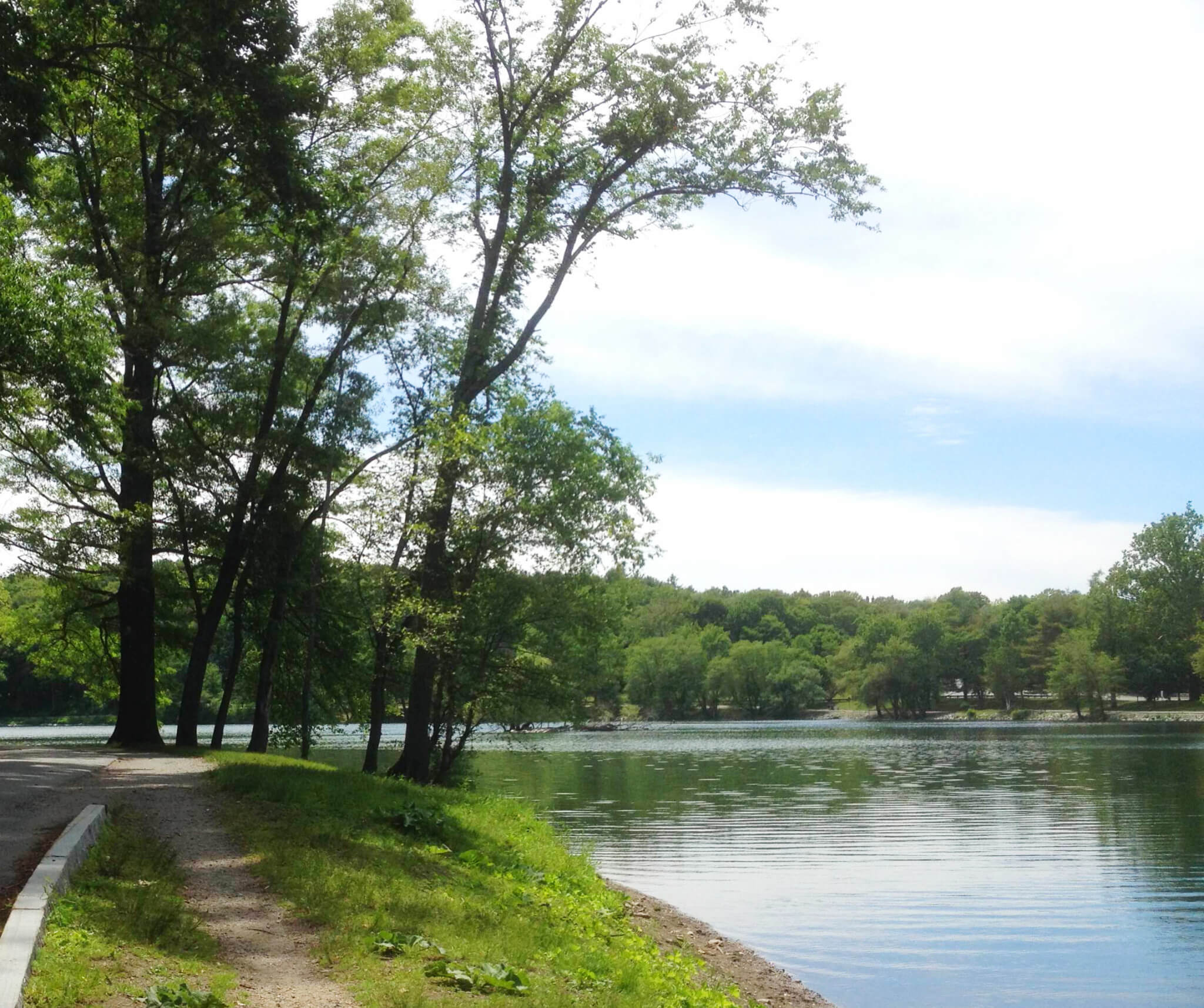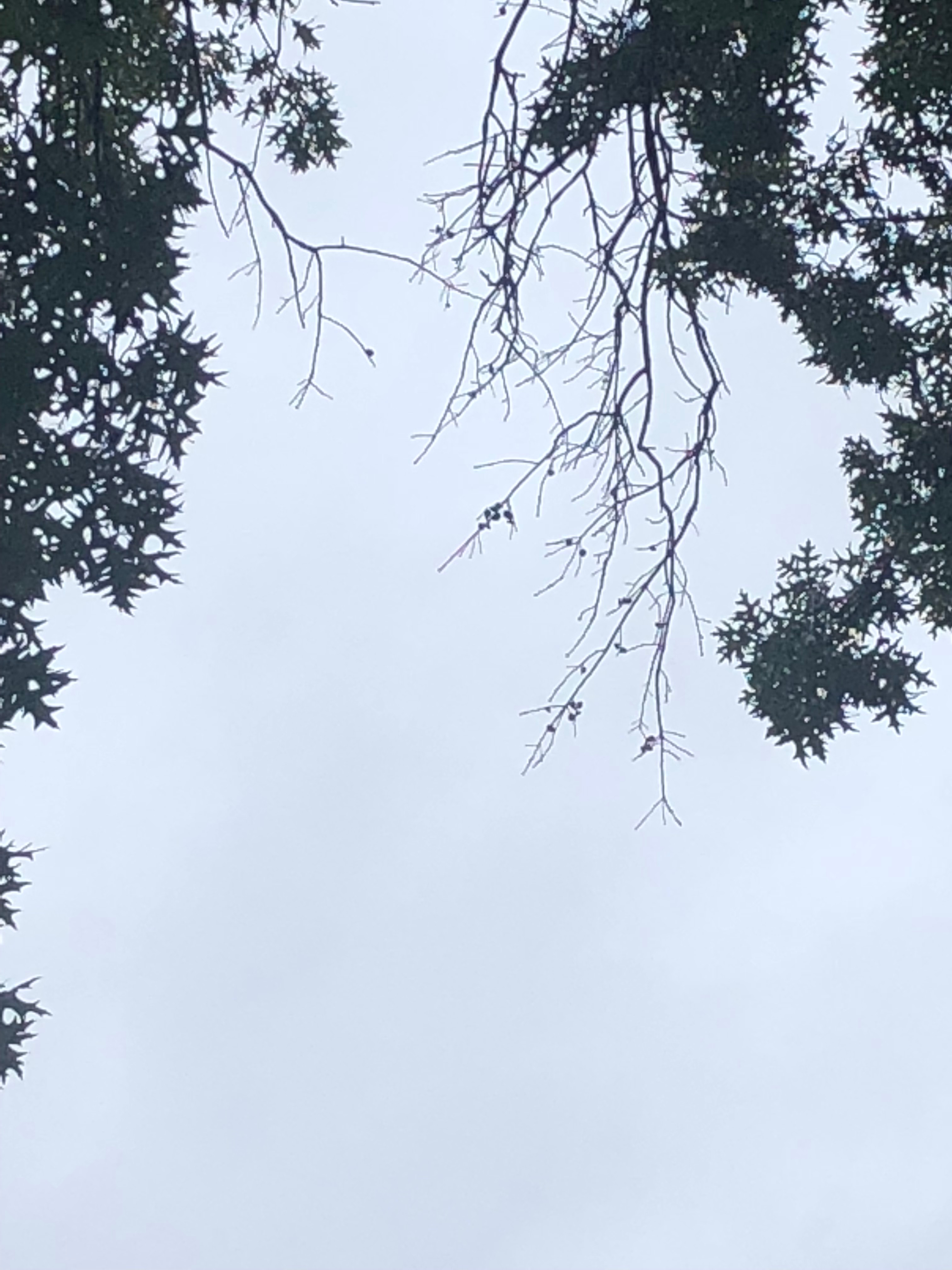
Time for Acorns
Seven days after the autumnal equinox, the sun shines brightly: it hangs high in the sky, inviting park goers and sun worshipers to enjoy the last vestiges of summer on the lawns and glades of McCarren Park. The crisp, unmistakable air of fall can already be felt below the ample canopy of the oak that grows near the corner of Lorimer and Nassau. The broad trunk and imposing height speaks eloquently about his old age. Despite his rugged bark, wrinkled and weathered like the face of an old man, this oak radiates a youthful aura from his healthy boughs and branches, still densely covered in green leaves. I slowly circle the stem close to the roots, as the drumming of the falling acorns keep a rubato tempo for the dynamic song of the rustling leaves..
I stop after completing a full circle and stand beneath the green vault, looking up in reverence like a Greek seer in the oracle of Zeus, trying to discriminate and decode the myriad of sounds that make up the oak’s speech: the faint claps and hisses of the hundreds of thousands of leaves animated by the wind. The only clear message that I can interpret from the rustle is the certainty of this tree’s presence in the same spot long after I am gone. I hold no doubts about the sacredness of this oak or the infallibility of his voice. But I am not a priest of the king of gods, and the oracle in Dodona is far away in time and distance from this corner of Brooklyn. I kneel down to study the velvety moss that covers the hollows where the roots branch radially before disappearing underground, always digging, holding, drinking. Squirrels rush above on the branches, carrying big bundles of green leaves for their dreys, dropping many of them as they move from one end to the other. The entire tree bustles with activity, as animals and plants all around, drawn by the shortening of daylight, prepare for the change of season. The still green giant himself must already be undergoing a few changes of his own, though these aren’t yet evident in the hue of his leaves. The ground around the tree, nevertheless, is covered by fallen leaves and perfect, little acorns. I pick one up and study the polished surface of the shell and the little scaly cup that holds it.
I realize with a smile that I hold the possibility of another green giant on the palm of my hand. I look at the silhouette of the Orthodox Cathedral of the Transfiguration of Our Lord, coming behind the trees at the south end of the park. I have no way of knowing if this is true, but I can’t help to think that a lovely acorn like this one inspired the shape of its dome, rather than the humble onion that gives these structures their name. I put the little nut in my pocket, thinking it will not reach its full potential. Or maybe one day it will. For now, I’ll save it as a little treasure, like a greedy squirrel.

A View from the Tropics
I was in my early twenties the first time I really saw an oak tree, during an extended visit to Boston while I was working on my thesis. I had surely seen oaks before that, most probably during a summer vacation I spent in Tennessee as an exchange student candidate. I was fifteen then, and as much as I loved and enjoyed nature I really didn’t care much about the names of the trees that grew everywhere in those mountains—girls and punk rock monopolized my curiosity during that tortuous transition to adulthood. So it was years later, walking around Jamaica Pond, one of the gems that inform the Emerald Necklace—Boston’s system of parks, designed by Frederick Law Olmsted during the final decades of the nineteenth century—that I became acutely aware of the ubiquitous oaks and their lobed leaves: thousands of little green hands reflected on the calm surface of the pond.
But the mighty species was already deeply rooted in my imagination long before that first close encounter. Although there are no oaks in Venezuela, the place where I grew up and developed my love for trees—in fact, only one species, native exclusively to Colombia, grows in all of South America— I became familiar with the shape of their leaves and acorns at a tender age. The Chip and Dale Disney cartoons were probably responsible for that early acquaintance. Later in childhood, on the pages of The Hobbit, I came across the character of Thorin Oakenshield, the dwarf King Under the Mountain, and for the first time I associated the oak with the idea of royalty. The Adventures of Asterix, the comic strips created by Goscinny and Uderzo, were also packed with oak trees, which were often a central element in the exploits of their fictional Celtic heroes.
Growing up near the equator, with only two distinctive seasons a year —verano, or dry season, and invierno, or rainy season—books and screens were naturally the only places where I could find oaks. Oaks, however, had always been there: in the aroma of the first sip of wine I ever had, in the nutty flavor of ham from acorn-fed hogs, in corks, barrels, and pieces of furniture, in the names of streets, institutions, and people. I certainly didn’t need to see an actual living oak to understand why it was considered the King of the Forest. But only when I finally stood before one was I able to grasp the idea in its full emotional dimension. I still keep the notebook I took that day to Jamaica Pond. The sketches and notes on its first pages speak of my fascination about these trees. And I still feel that same amazement every time I see an oak tree growing anywhere.

The Oak King
Oaks have been around for a long time. According to some sources, fossil evidence shows that members of the family Fagaceae, which include beeches and oaks, grew in the late part of the Cretaceous period. The oldest North American oak fossils come from Paleocene deposits as old as 50 to 55 million years. It was around this time that the oak became a successful colonizer of the northern half of our planet, becoming much later an invaluable ally to the earliest members of our species. Its hard wood was used as raw material for all kinds of objects essential to our survival: weapons, tools, containers, and shelters. Taschen’s encyclopedic The Book of Symbols—one of my favorite starting points when it comes to discussing images—mentions ancient legends that tell about an era prior to the development of agriculture, when acorns were a staple food for our gathering great grandparents. Even their hollow trunks “provided a much sought after coffin” for their dead. It was inevitable for such an important tree—not only a source of life, but also a final resting place for humans—to become divinized as our developing imagination tried to make sense of the world.
As I hinted above, the ancient Greeks associated the oak with Zeus, the King of Gods presiding over the Olympic pantheon. In his classic The Golden Bough, Frazer tells us that Zeus addressed mortals through the fearsome cracking of thunder, but also through the gentle rustle of leaves. It was the task of priests at the oracular oak tree of Dodona, in Epirus, to interpret the god’s decrees in these sacred sounds.
This identification of lightning and thunder with the oak is not unique to ancient Mediterranean culture. In northern Europe, Celts worshipped the oak as the tree of Taranis, God of Thunder. Pliny the Elder, in his Natural History, wrote about how druids held oaks as the most sacred of trees. He even suggested, perhaps erroneously from an etymological perspective, that the word druid—the sylvan priests of Celts—derives from the Celtic word duir-id, which translates as “wise with the oak.” Thor, the Norse god of thunder, trivialized by Marvel and Hollywood, was also worshipped through the oak tree. In fact, the Christianization of Germanic Europe is believed to have started with the cut down by a Christian missionary of a sacred oak tree dedicated to Thor. Even Jehovah, the one and only God in Judeo-Christian monotheism, chose an oak grove not far from today’s Hebron to appear to Abraham (Genesis 18-1), though other verses in Old Testament condemn the pagan rituals celebrated around oaks. It is interesting to note that the connection between oaks and thunder is apparently not an arbitrary one. Because of their height and water content, oak trees are more often hit by lightning than any other tree. And civilizations have universally heard the voice of god in thunders.

In The Oak King, the Holly King, and the Unicorn, John Williamson’s exhaustive analysis of the Unicorn Tapestries exhibited at The Met Cloisters, the oak, depicted on all six panels, is presented as a deeply ingrained symbol in the Indo European pre-Christian psyche, one that through a syncretic process resurfaces in the Middle Ages transfigured into the representation of Christ, the savior of the new religion that spread through Europe after the fall of the Roman Empire. “The widespread motif of a ‘dying god,’ or vegetation deity who is sacrificed or sacrifices himself for the benefit of mankind, is basic to the seasonal motifs of agrarian societies,” explains Williamson.
For northern European pagan societies, this deity was personified by the Oak King, a highly regarded tree that represented “a time of the year when the days begin to lengthen and brighten, after the darkness of winter.” It was natural for early Christian missionaries to transfer the idea of a death conquering Messiah to the image of the Oak King. As Europe transitioned into monotheism, Christ became closely associated to the old forest god of the old religion, which decayed at the beginning of every winter, only to come back to life in winter solstice, like other solar divinities of the ancient world. In the medieval conception of this cosmic drama of decline and renewal, the oak and the cross became, not only complementing, but interchangeable symbols.

Fading Light
A week has gone by. Days keep getting shorter, but many leaves still cling to the branches of our oak. Some clusters do show curly, dry lobes, but only a few branch ends seem totally naked. The dry leaves on the ground outline the girth and shape of the canopy below the overcast sky, as the planet advances inexorably toward the completion of another revolution around the sun, when our star will be directly over the Tropic of Cancer and away from the northern hemisphere.
People stroll on the paths of McCarren in their light coats and hoodies. It isn’t really cold, but the light of summer is definitely gone. Now it seems obvious that the king has already surrendered his crown and scepter. A new king, the holly, has taken over, thus assuring the safety of nature as the solar king declines and we celebrate the harvest in the waning season. Wood will burn in hearths, crackling like infant suns while we wait for the return of the Sun King. Below the darkening sky, I hear, loud and clear, the promise of a full bloom in the next summer solstice.


